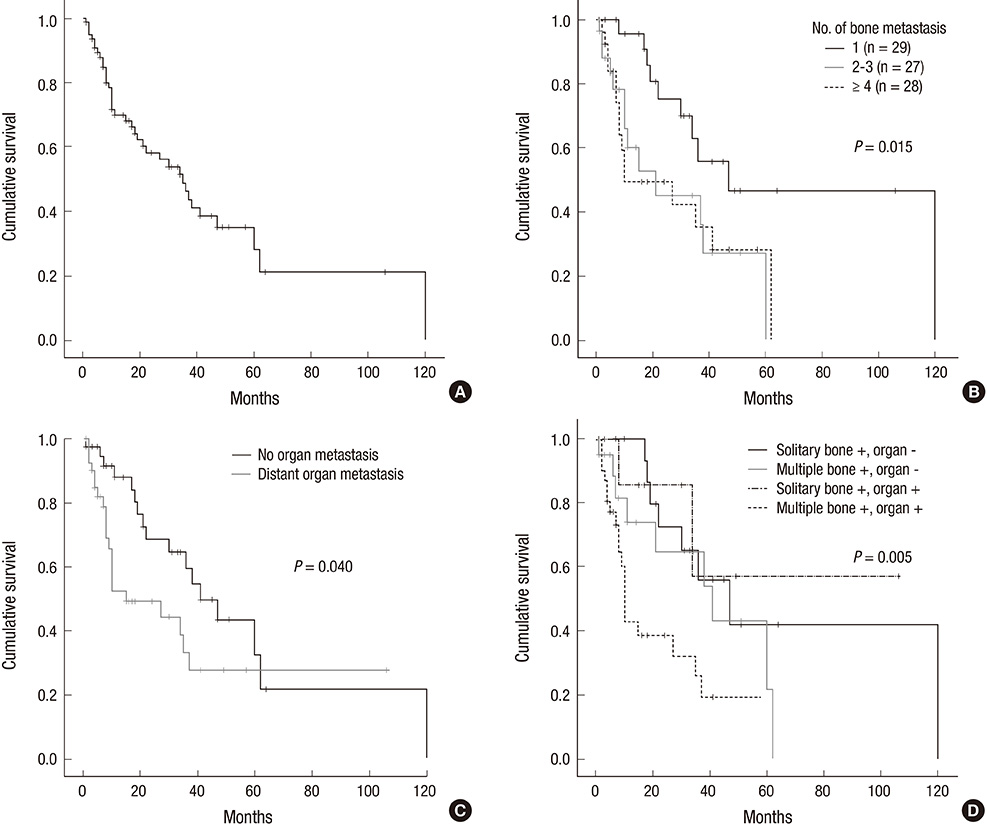J Korean Med Sci.
2014 Mar;29(3):357-362. 10.3346/jkms.2014.29.3.357.
Non-Spine Bone Metastasis as an Initial Manifestation of Cancer in Korea
- Affiliations
-
- 1Department of Orthopaedic Surgery, Seoul National University Hospital, Seoul, Korea. hik19@snu.ac.kr
- 2Musculoskeletal Tumor Center, Seoul National University Hospital, Seoul, Korea.
- KMID: 1734922
- DOI: http://doi.org/10.3346/jkms.2014.29.3.357
Abstract
- Non-spine bone metastasis accounts for approximately 20% of all skeletal metastases, but little data have been published that focused on bone metastasis to the pelvis and extremities as an initial manifestation of cancer. We determined 1) clinicopathologic characteristics of patients who presented with non-spine bone metastasis of unknown primary malignancy, and 2) process by which the diagnosis of primary cancer was made. We retrospectively reviewed 84 patients with bone metastasis of unknown primary cancer site at the time of presentation. The study population consisted of 56 men and 28 women, with a mean age of 59.1 yr (17.5-85.6 yr). The average follow-up period was 20.8 months (1-120 mo). Primary cancer site was identified in 79 patients (94.0%), and was determined to be the lung (46.4%), kidney (13.1%), liver (9.5%), thyroid (8.3%), and prostate (4.8%). Five-year overall survival rate was 28.0%. Multiple bone metastases, distant organ metastasis, and multiple bone with organ metastases were the significant prognostic factors in univariate analysis. Multiple bone metastases remained significant after multivariate analysis (P = 0.008). Lung cancer is the most common site of primary cancer, and patients with multiple bone metastases have a poor prognosis, possibly due to disseminated cancer and a greater tumor burden.
Keyword
MeSH Terms
-
Adolescent
Adult
Aged
Aged, 80 and over
Bone Neoplasms/mortality/pathology/*secondary
Female
Follow-Up Studies
Humans
Kidney Neoplasms/pathology
Liver Neoplasms/pathology
Lung Neoplasms/pathology/radiography
Male
Middle Aged
Prognosis
Prostatic Neoplasms/pathology
Republic of Korea
Retrospective Studies
Survival Rate
Thyroid Neoplasms/pathology
Young Adult
Figure
Reference
-
1. Nottebaert M, Exner GU, von Hochstetter AR, Schreiber A. Metastatic bone disease from occult carcinoma: a profile. Int Orthop. 1989; 13:119–123.2. Rougraff BT. Evaluation of the patient with carcinoma of unknown origin metastatic to bone. Clin Orthop Relat Res. 2003; (415):Suppl. S105–S109.3. Barón MG, de la Gándara I, Espinosa E, de Paredes ML, Zamora P, Mondéjar JL. Bone metastases as the first manifestation of a tumour. Int Orthop. 1991; 15:373–376.4. Rougraff BT, Kneisl JS, Simon MA. Skeletal metastases of unknown origin: a prospective study of a diagnostic strategy. J Bone Joint Surg Am. 1993; 75:1276–1281.5. Riccio AI, Wodajo FM, Malawer M. Metastatic carcinoma of the long bones. Am Fam Physician. 2007; 76:1489–1494.6. Zeng L, Chow E, Zhang L, Culleton S, Holden L, Jon F, Khan L, Tsao M, Barnes E, Danjoux C, et al. Comparison of pain response and functional interference outcomes between spinal and non-spinal bone metastases treated with palliative radiotherapy. Support Care Cancer. 2012; 20:633–639.7. Simon MA, Karluk MB. Skeletal metastases of unknown origin: diagnostic strategy for orthopedic surgeons. Clin Orthop Relat Res. 1982; 166:96–103.8. Simon MA, Bartucci EJ. The search for the primary tumor in patients with skeletal metastases of unknown origin. Cancer. 1986; 58:1088–1095.9. Jacobsen S, Stephensen SL, Paaske BP, Lie PG, Lausten GS. Skeletal metastases of unknown origin: a retrospective analysis of 29 cases. Acta Orthop Belg. 1997; 63:15–22.10. Katagiri H, Takahashi M, Inagaki J, Sugiura H, Ito S, Iwata H. Determining the site of the primary cancer in patients with skeletal metastasis of unknown origin: a retrospective study. Cancer. 1999; 86:533–537.11. Destombe C, Botton E, Le Gal G, Roudaut A, Jousse-Joulin S, Devauchelle-Pensec V, Saraux A. Investigations for bone metastasis from an unknown primary. Joint Bone Spine. 2007; 74:85–89.12. Berrettoni BA, Carter JR. Mechanisms of cancer metastasis to bone. J Bone Joint Surg Am. 1986; 68:308–312.13. Tsukushi S, Katagiri H, Kataoka T, Nishida Y, Ishiguro N. Serum tumor markers in skeletal metastasis. Jpn J Clin Oncol. 2006; 36:439–444.14. Hoshi M, Taguchi S, Hayakawa K, Ieguchi M, Nakamura H. Evaluation of clinical problems associated with bone metastases from carcinoma from unknown primary sites. Arch Orthop Trauma Surg. 2011; 131:59–64.15. Kole AC, Nieweg OE, Pruim J, Hoekstra HJ, Koops HS, Roodenburg JL, Vaalburg W, Vermey A. Detection of unknown occult primary tumors using positron emission tomography. Cancer. 1998; 82:1160–1166.16. Sève P, Billotey C, Broussolle C, Dumontet C, Mackey JR. The role of 2-deoxy-2-[F-18]fluoro-D-glucose positron emission tomography in disseminated carcinoma of unknown primary site. Cancer. 2007; 109:292–299.
- Full Text Links
- Actions
-
Cited
- CITED
-
- Close
- Share
- Similar articles
-
- Spine Metastases as the Initial Sign of Differentiated Thyroid Carcinoma: Two Case Reports
- Bone Metastasis in Gastric Cancer Patients
- Characteristics of Bone Metastasis of Colorectal Carcinoma
- Absent Sternum as the First Manifestation of Bone Metastasis on Bone Scintigraphy
- A case of rectal cancer with sternal metastasis as initial presentation


